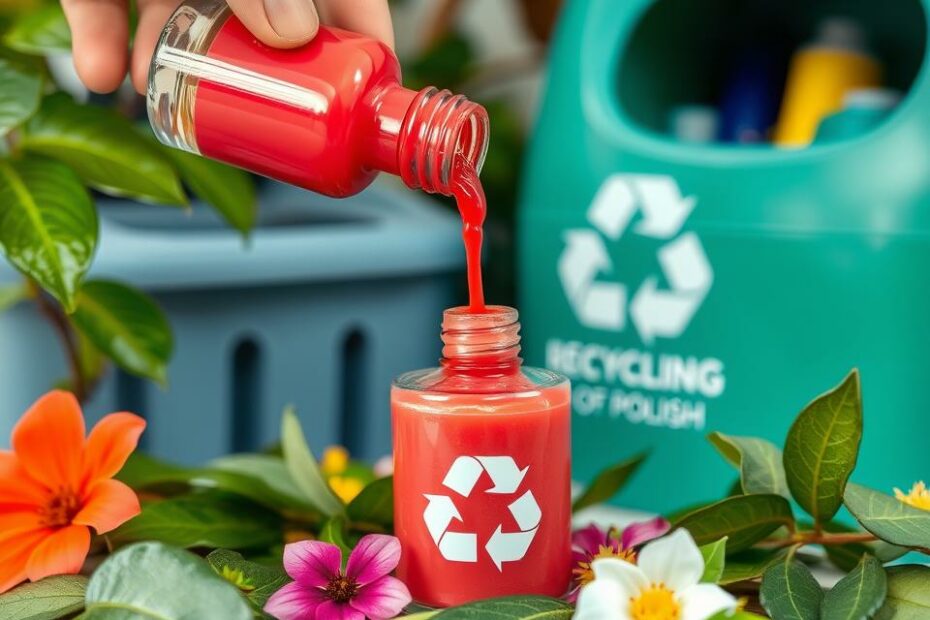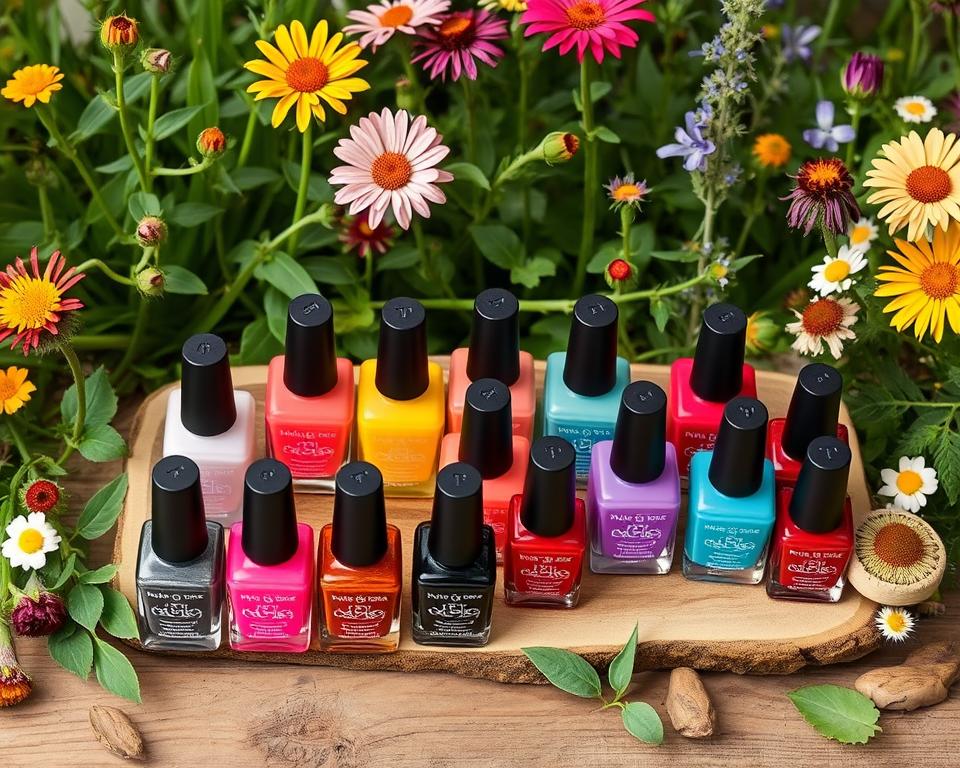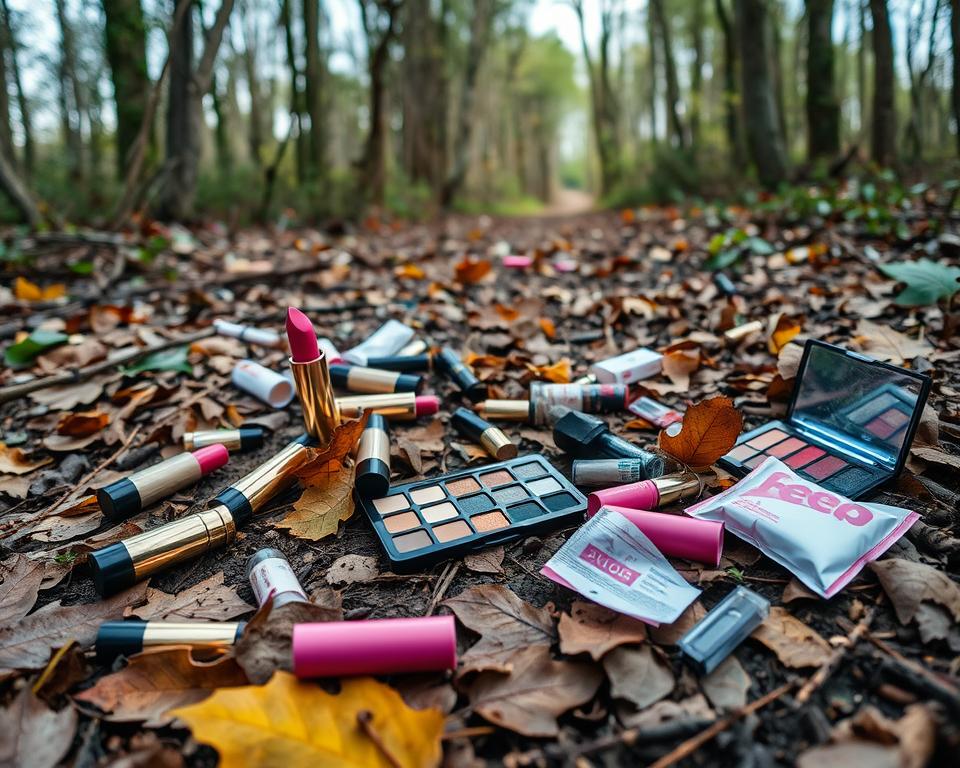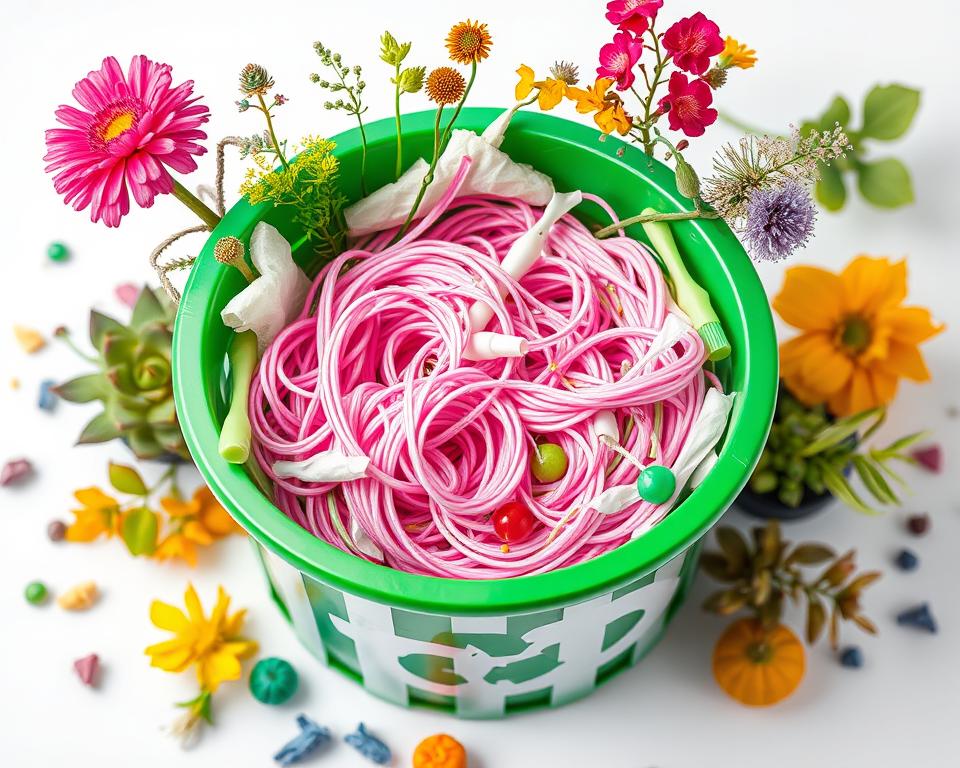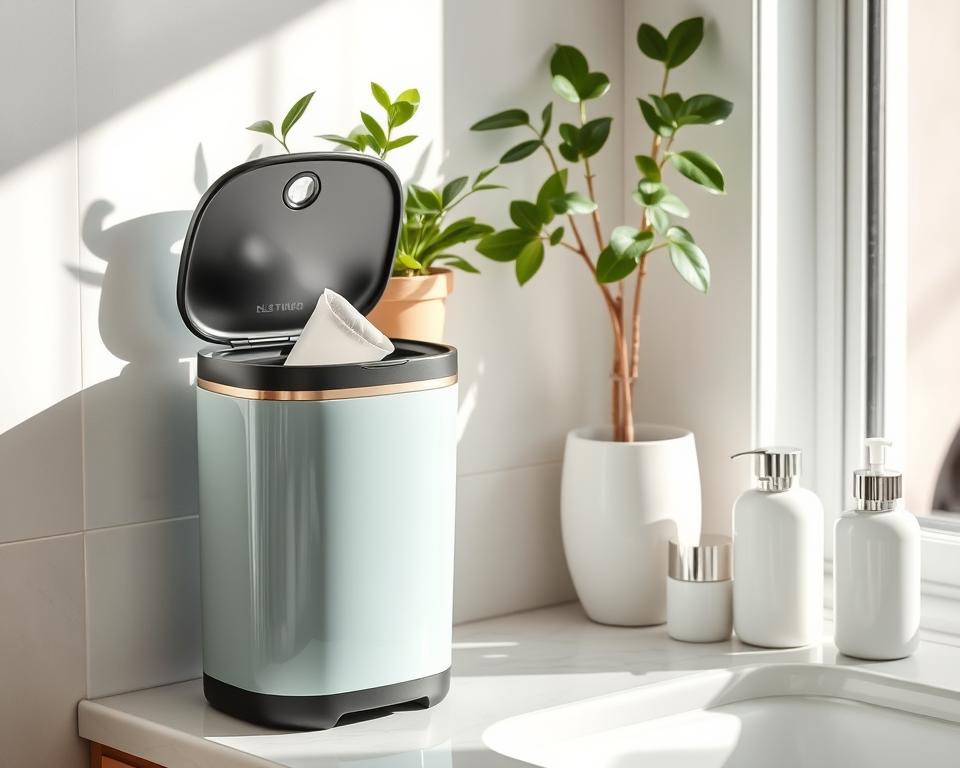Did you know the EPA has fined over $4.6 million in the last four years? This is for small businesses that didn’t label hazardous waste right or dispose of it properly. Nail polish bottles are considered household hazardous waste. If you don’t dispose of them right, you could face big fines and harm the environment. We’ll share expert tips on how to safely get rid of your old nail polish.
Key Takeaways
- Nail polish bottles are considered household hazardous waste due to their flammable chemicals and synthetic materials.
- Most curbside recycling schemes do not accept nail polish bottles, and even specialized recyclers like TerraCycle avoid them due to contamination risks.
- Proper disposal methods include taking the bottles to a household hazardous waste collection center or following specific steps to dry out the polish before throwing away the bottle.
- Extending the life of nail polish by adding nail varnish remover can help reduce waste, and purchasing colors you’ll use frequently is also recommended.
- Switching to more environmentally-friendly nail polish formulas can be a great way to minimize your impact on the planet.
Understanding the Hazards of Nail Polish
Nail polish might seem harmless, but it’s filled with dangerous ingredients. It’s classified as hazardous waste by the Environmental Protection Agency (EPA). This means it’s a toxic substance that needs careful disposal.
Common Hazardous Ingredients
Nail polish has flammable, toxic, and inhaled chemicals. These include acetone, benzene, ethyl acetate, and more. These can irritate skin and mucous membranes. Some, like benzene, are known to cause cancer.
Potential Health and Environmental Risks
- These chemicals can cause respiratory issues, skin irritations, and hormonal problems.
- The vapors from nail polish also pollute the air. This affects both personal and environmental health.
New nail polish formulas have replaced some harmful ingredients. But, they’re still considered hazardous waste. It’s important to use and dispose of nail polish responsibly. This helps reduce the potential health risks and environmental impact of this common beauty product.
Why Proper Nail Polish Disposal Matters
Environmental Impact
Throwing away nail polish without care can harm our planet. The toxic chemicals in it can pollute soil and water. This can hurt plants and animals living in these areas.
The Environmental Protection Agency (EPA) calls nail polish waste hazardous. It needs special ways to be thrown away to keep our environment safe.
The EPA says nail polish and remover are harmful waste. If not disposed of right, they can contaminate our water and harm wildlife. They can also pose risks to people and pets.
Even “5-free” polishes, like those from RGB, are still harmful waste. They need to be thrown away carefully.
Businesses that make a lot of hazardous waste must tell the government. Most nail salons make less than 220 pounds a month. This is considered a small amount.
It’s crucial to dispose of nail polish correctly. This helps keep our soil and water clean. By doing this, we can reduce the harm caused by this beauty product.
Disposing of Nail Polish
There are a few ways to safely get rid of nail polish. Try to use up what’s left or share it with friends and family. This way, you reduce waste and keep it out of landfills.
For empty bottles, take off the cap and let them dry before tossing them. You can also take them to a hazardous waste facility. This is important because nail polish has toxic chemicals.
In Florida, businesses must send waste nail polish to a hazardous waste facility if it’s under 140 degrees Fahrenheit. Homeowners can throw it away in regular trash if it’s from a household. Businesses that produce over 220 pounds of hazardous waste in a month must notify the state and federal government. Nail salons are usually considered small generators if they produce less than 220 pounds a month.
Choosing non-toxic nail polish can help the environment. Look for ones without formaldehyde, toluene, and dibutyl phthalate. Companies like Chemwise offer recycling services for liquid nail polish through their SMARTbeauty pack.
By following these tips and looking for eco-friendly options, you can dispose of nail polish safely and responsibly.
Reusing and Repurposing Nail Polish
Nail polish lovers, rejoice! Your favorite polishes don’t have to go to waste. With a bit of creativity, you can use them for many DIY projects. Whether it’s a nearly empty bottle or a collection of colors, these tips will breathe new life into your old polish.
Creative DIY Projects
Still have polish left? Use it for small home projects. Reusing nail polish can make old items new again. For instance, clear polish can fix frayed threads on clothes or shoelaces. You can also use it to cover up shoe scratches, making them look like new.
Want to get crafty? Repurpose nail polish for crafting. It’s great for reviving household items, making unique jewelry, or decorating. Let your creativity shine!
Got polish you won’t use? Donate it to friends or a local group that accepts donations. This way, your polish can bring joy to someone else.
Looking to organize with nail polish? Use different colors to sort items. This practical use of polish can help you stay organized and add a personal touch to your space.
By exploring DIY projects with nail polish, you can make your collection last longer and reduce waste. Get creative and enjoy the fun of reusing your favorite polishes.
Donating Unused Nail Polish
Donating unused nail polish is a great way to keep it from being thrown away. Look for local centers or organizations that accept these donations. It’s a green choice compared to just tossing it out.
Many thrift stores sell donated nail polish because it sells fast. The Buy Nothing Project encourages neighbors to give freely, which includes nail polish. Sites like Glambot and Poshmark also let you sell or donate makeup, including nail polish.
Before you donate, make sure the polish is still good and not dried out or expired. Check with the organization to see what they need and if there are any rules. They might want it in its original packaging.
Donating nail polish helps reduce waste and helps others. Women’s shelters often accept makeup donations, including nail polish. By giving your unused polish a new home, you’re helping the environment and your community.
Safe Storage of Nail Polish
Storing your nail polish right is key to keeping it fresh and lasting longer. Here are some easy tips to help you:
- Always keep the caps on when you’re not using the polish. This stops it from drying out or getting dirty.
- Store your polish at room temperature, away from sunlight or heat. This helps it stay good for longer.
- Don’t keep polish in the bathroom. The changing temperature and humidity can harm it.
- For the best results, keep the bottles upright. This stops the colors from settling at the bottom.
Experts say gel and lacquer polish last 1-3 years. Regular polish can last 12-18 months if stored right. Primers last 1-2 years, and creams and oils can last 1-2 years unopened and 1 year once opened.
Storing your polish right is not just about keeping it good. It’s also about keeping it safe. Disinfectants can stay effective for up to 10 years unopened and 2-3 years once opened. By following these tips, you can keep your polish collection in great shape. This ensures a safe and fun manicure time.
Disposing of nail polish
It’s important to dispose of nail polish the right way to protect our environment and health. Nail polish has harmful chemicals that need careful handling. It’s a hazardous waste because it can catch fire easily.
Try to use up all the nail polish you have or share it with others. If you have empty bottles, take off the cap and let them dry out. Then, you can throw them away. You can also take nail polish to a local hazardous waste facility for safe disposal.
In Florida, businesses that throw away a lot of hazardous waste must follow certain rules. But, most nail salons don’t have to because they don’t throw away that much. According to the Florida Administrative Code, you can throw away nail polish waste in regular trash or through special programs.
Recycling nail polish is another good option. Companies like Chemwise offer a mail-in service for recycling liquid nail polish. They take the polish, glass containers, and plastic applicators and recycle them.
| Disposal Method | Considerations |
|---|---|
| Use up or give away unused nail polish | Reduces waste and ensures proper disposal |
| Take to local hazardous waste facility | Ensures safe and responsible disposal of hazardous materials |
| Recycle through specialized services | Diverts nail polish and containers from landfills |
By using these safe ways to dispose of nail polish, we can all help protect our planet. Remember, how we dispose of nail polish is very important.
Environmentally Friendly Alternatives
For those who care about the planet, there are better choices than regular nail polish. Toluene-free nail polish is a safer pick than most. And natural nail care products are even greener.
Toluene-Free Nail Polish
Toluene in many polishes can harm your health, like causing “painter syndrome.” Toluene-free polish is a safer choice. It lowers the risks from this harmful chemical.
Natural Nail Care Options
- Buffing nails to create a natural sheen without polish
- Using plant-based, vegan nail polish made with sustainable ingredients
- Opting for eco-friendly nail polish remover, such as those with oil-based or sugar-based formulas
These natural options are good for the planet and your nails. They also cut down on harmful chemical exposure.
Many eco-friendly nail polish brands have recycling programs. They let customers return used products. This cuts down on waste and supports a greener economy. Choosing these alternatives helps make the nail care world more sustainable.
Tips for Minimizing Nail Polish Exposure
To keep yourself and the environment safe, it’s important to use nail polish wisely. By taking a few simple steps, you can enjoy a beautiful manicure without harming your health or the planet.
- Follow Application Instructions: Always use nail polish as the maker says. This means turning on the fan and opening a window to cut down on vapors.
- Leave the Room: After you’ve applied nail polish, step out. This helps you avoid breathing in the chemicals that come out while it dries.
- Glove Up: When you’re taking off nail polish, wear gloves. This keeps your skin from touching the harsh chemicals in the remover.
- Dispose Properly: Don’t dump leftover nail polish in the drain or trash. Look up the right way to get rid of it in your area.
- Explore Safer Alternatives: Look for nail polish that doesn’t have toluene, formaldehyde, or DBP. These kinds are getting more common.
By following these tips, you can enjoy your manicure while keeping yourself and the planet safe.
| Tip | Description |
|---|---|
| Follow Application Instructions | Use nail polish as the maker says, including turning on the fan and opening a window. |
| Leave the Room | After applying nail polish, leave the room to avoid prolonged exposure to the volatile compounds released during drying. |
| Glove Up | When removing nail polish, wear gloves to limit skin contact with the acetone or other solvents used in the process. |
| Dispose Properly | Never pour leftover nail polish down the drain or throw it in the trash; instead, consult local hazardous waste guidelines for the appropriate disposal methods. |
| Explore Safer Alternatives | Consider switching to toluene-free, formaldehyde-free, and DBP-free nail polish formulas, which are becoming increasingly available in the market. |
Conclusion
We’ve talked about why it’s important to dispose of nail polish safely. This protects our environment and health. We learned about the harmful ingredients in nail polish and the dangers they pose.
Nail polish should not be thrown away carelessly. Its harmful chemicals can harm the soil and water. Instead, we can donate unused polish, use containers for DIY projects, or choose eco-friendly options.
By choosing sustainable nail care and participating in community programs, we can reduce the harm caused by nail polish. Small actions from all of us can make a big difference. Let’s work together for a cleaner, healthier world.
FAQ
What are the recommended methods for safely disposing of nail polish?
To safely dispose of nail polish, use it up, give away what’s left, or take empty bottles to a hazardous waste facility. Remove the cap and let the bottle dry before throwing it away.
What are the common hazardous ingredients in nail polish?
Nail polish has toxic chemicals like acetone, benzene, and toluene. These can be harmful if inhaled or touch your skin. Benzene is especially dangerous because it can cause cancer.
What are the potential health and environmental risks of improper nail polish disposal?
Throwing away nail polish can pollute soil and water. The chemicals in it can harm animals and plants. It’s important to dispose of it safely to protect our environment.
How can I reuse or repurpose nail polish?
You can use leftover polish for small fixes, like fixing frayed threads. You can also donate it to friends or a local center. This way, it won’t go to waste.
Where can I donate unused nail polish?
Look for local centers or organizations that accept nail polish donations. Giving away your polish helps others and saves resources.
How should I store nail polish to ensure its safety and longevity?
Keep nail polish bottles capped and out of reach of kids. Store them in a cool, dark place. This helps keep the polish fresh and safe.
What are some environmentally friendly alternatives to traditional nail polish?
Toluene-free polish is less toxic than regular polish. Natural nail care, like buffing, is also a greener option.
How can I minimize my exposure to the hazardous chemicals in nail polish?
Follow the instructions on the nail polish label. Use it in a well-ventilated area and leave the room after use. This reduces your exposure to harmful fumes.
Source Links
- https://nicelypolished.co.uk/blog/recycle-your-nail-polish-bottles
- https://www.nailsmag.com/604172/how-to-properly-dispose-of-common-nail-products
- https://barehands.us/blogs/new-layout/the-only-way-to-properly-dispose-of-nail-polish-plus-ideas-for-repurposing
